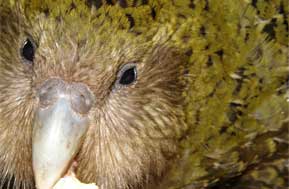What makes the Kakapo so unique?
One of the most notable features of the kakapo, is its distinctive, musty odour. And then there's the way it looks and behaves...
- It cannot fly, although it has large wings
- It walks and jumps and is an excellent climber
- It is nocturnal and can be found feeding on the ground or 20m up a rimu tree
- It “skraarks” loudly like other parrots but you might mistake other calls for a braying donkey, a grunting or squealing pig, a booming bittern; and it also produces a nasal metallic noise called “chinging”.
It's a parrot that looks like an owl, or a giant budgie
Here is a link to the sound of a female Kakapo singing Listen

Once out in the open, the kakapo will reveal its large size, and the startling mottled moss-green body feathers that provide perfect camouflage in New Zealand's native forest.
The softness of the feathers are represented in the second part of the scientific name Strigops habroptila.
A closer encounter will reveal that thick, musty kakapo smell. Strong and distinctive , the odour alerts dogs, cats and other predators to the presence of the bird and was a primary cause of the kakapo's rapid decline. People are captivated by the un-birdlike behaviour of this critically endangered parrot. Its waddling gait, curiosity, wide range of calls, and comic antics meant that the kakapo was even occasionally kept as a pet by early settlers.